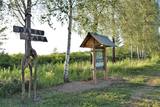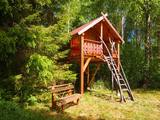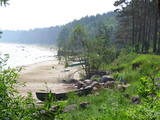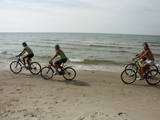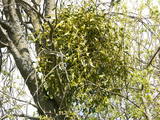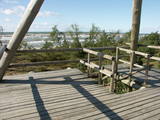| Нo | Название | Описание |
|---|---|---|
|
Kokneses dabas taka (5,65 km) ved gar Daugavas un Pērses krastiem un savieno Kokneses parku un Likteņdārzu. Pastaigā pa dabas taku var doties no jebkuras sevis izvēlētas vietas, kas vijas cauri Kokneses parkam. Takā izveidotas laipas, tiltiņi, informācijas stendi un norādes. |
||
|
Interesantā būve, kurai Baltijas valstīs grūti atrast līdzinieku, ir meklējama 2 km ziemeļaustrumos no Kirblas (Kirbla). 307,8 m garo arkveida tiltu pāri Kazari upei (Kasari jõgi) uzcēla 1904. g. deviņu mēnešu laikā. Tajā brīdī to uzskatīja par Eiropas garāko šāda tipa dzelzsbetona tiltu. Tagad to var šķērsot tikai ar kājām vai ar divriteni. Tumšajā diennakts laikā tilts ir skaisti izgaismots! Tā ievērojamais garums ir skaidrojams ar apstākli, ka pavasara palos Kazari palienes applūst lielās platībā. |
||
|
Здесь ждут в гости как группы, так и индивидуальных посетителей. Хозяева предлагают насладиться баней по-черному, пообедать и попробовать испеченного по древним рецептам суйтского хлеба, пирогов и особого печенья с семечками. |
||
|
Гончар предлагает широкий выбор деятельности – осмотр мастерской, точение глиняной посуды, рисование, изготовление барабанов и кукол. Покупка сделанных работ. Демонстрация игры на барабане. |
||
|
Герцог Екаб (Jēkabs) правил в Курземе и Земгале с 1642 по 1682 год. В те времена стремительно развивалось кораблестроение, появились первые мануфактуры и увеличились объемы сельскохозяйственного производства. Корабли экспортировали товары в Европу, отправлялись на Тобаго и в Гамбию, моряки основывали там колонии и везли в Европу сахар, кофе и приправы. В тот период в Латвии появился картофель, полюбившийся местным жителям лишь пару столетий спустя. Курземский деликатес – угри из озера Усмас: из них варят супы, их жарят и коптят; в сезон готовят также саргана, корюшку и салаку, а килька, сельдь и лосось доступны круглый год. Здесь пекут ржаной хлеб, кисло-сладкий хлеб или скландраусисы, варят ячневую кашу с простоквашей или букстиньпутру. Суйтские женщины предлагают научиться готовить традиционные блюда. К летнему солнцевороту во многих местах готовят Янов сыр, в обычные дни предлагаются и другие вкусные сыры из коровьего и козьего молока. Популярны также блюда из мяса домашнего скота и птицы, их готовят в том числе в глиняных горшочках вместе с кореньями. На гарнир подают тыкву, овощи, коренья, грибы, бобы или перловку с невероятно вкусными соусами. В сезонном предложении трактиров можно найти дичь: оленину, зайчатину, мясо косули и бобра. Гурманов ждут пироги, медовый торт и булочки с маком, которые в Кулдиге пекут по средневековым рецептам. На сладкое – черничные клецки или бигузис из ржаного хлеба с медом, брусникой или клюквой и сливками. Жажду можно утолить душистыми травяными чаями и медом. Головокружительные впечатления вы сможете получить во время дегустации домашних вин, за кружкой вкусного пива или стаканчиком более крепкого напитка. |
||
|
Хозяин – банщик, травовед, массажист, мастер Рейки – интересуется этнокультурой и предлагает гостям прадедами проверенные способы настоящего отдыха и укрепления здоровья – банные эдукации, секреты травоведения, восстановление связи с природой, водные процедуры. |
||
|
Этот маршрут предлагает вам отличную возможность посетить самый большой остров Эстонии – Сааремаа, который является своеобразным символом для туризма по Эстонии. На острове находятся один из наиболее впечатляющих метеоритных кратеров в Северной Европе, Епископский замок Курессааре, самая крутая отвесная скала в Эстонии и множество других интересных туристических объектов. |
||
|
Гордость хозяйства – стадо коз численностью ~ 100 голов. Из полученного молока производят сыр, творог и йогурт. Интересующиеся могут отправиться на экскурсию, понаблюдать за животными, попробовать и приобрести продукты здорового питания, произведенные с использованием методов органического сельского хозяйства. В расположенном поблизости пруду можно ловить рыбу, а затем каждый сам может пожарить на гриле свой улов. |
||
|
В письменах название Кандава впервые упомянуто в 1230 году. В 1253 году в верхней части крутого берега древней долины Абавы Ливонский орден построил каменный замок, у подножья которого образовалось поселение. В XVII веке Кандава стала важным торговым центром. Эпидемия чумы и события Первой мировой войны тяжело отразились на городке и его населении. Права города Кандава получила в 1917 году. В советское время спортивный комплекс Яункандавского сельскохозяйственного техникума стал популярным местом для проведения тренировок. |
||
|
Лиелстраупский замок - единственная сохранившаяся в Латвии постройка, где в одном здании объединены средневековый замок и церковь. Строительство замка началось в 1263 году. Постройка серьезно пострадала во время XVII и XVIII вв., а также во время революции 1905 года. Комплекс восстановлен в 1909 г. по проекту архитектора В. Бокслафа. В Лиелстраупской церкви находится несколько художественных памятников - хоры органа XVII в. и живопись кафедры XVIII в. В 1944 г. в церкви установлены витражи художника С. Видберга «Голгофа» и «Рождение Христа». На башне замка видны часы, сделанные местным часовщиком Айде, а на стене церкви - солнечные часы. В парке замка следует осмотреть построенную в 1744 году деревянную колокольню. В 1938 году в церкви открыли мемориальную доску, установленную в память о павших во время Первой мировой войны и в боях за свободу. С 1963 г. в замке работает наркологическая больница. Церковь можно осмотреть во время богослужений, а остальной комплекс зданий - извне. |
||
|
В Рое можно посетить как песчаный пляж с благоустроенной инфраструктурой, так и каменистое взморье. На каменистом взморье находится Ройский морской валун примерно 2 м высотой и 12,5 м в обхвате. Для морского побережья характерно своеобразное очарование ландшафта с разбросанными камнями и неспешным течением времени. У впадения речки Силупите в море еще сейчас можно увидеть деревянные фрагменты старинной баржи и остатки железных гвоздей того времени. Начиная с 1939-го года Роя была «начальным» пунктом так называемой «закрытой зоны», где вплоть до 1993-го года находилась зона дислокации Советской армии и флота. В дюнах возле улицы Краста еще можно увидеть наследие советского времени. Здесь находится большая насыпь из бетона, с которой в свое время пограничники наблюдали за морем и ловили нарушителей границы. За дюнами находился полигон пограничников со всем необходимым. В Рое находилась как пограничная застава, так и радиолокатор противовоздушной обороны. (Источник: Ройский ТИЦ) |
||
|
Viena no ciema augstākajām būvēm. Koka vējdzirnavas cēla 1930. g. un ar vēja palīdzību darbināja septiņus gadus (vēlāk ar elektromotoru). Pie dzirnavām atrodas Jūrmalciema tūrisma informācijas punkts, stends un atpūtas vieta. Turpat redzami veco, zvejnieku pamesto liellaivu koka korpusi. |
||
|
Усадьба Брукнас является неожиданным сюрпризом в этом месте и в это время. Строительство здания поместья началось в середине 18-го века, а столетие спустя – перестроено. В первой половине 20-го века в здании усадьбы была размещена начальная школа, а в советское время - обустроены квартиры. Сейчас здание усадьбы возродилось в новом качестве - как по форме, так и по содержанию - как в прямом, так и в переносном смысле. Здесь действует общественная организация "Сообщество горных благословений", летом проводятся детские и молодежные лагеря и другие мероприятия. Внутри здания сохранилась старая деревянная резная лестница, оконные ставни и латунные дверные петли. Возводится церковь. Можно осмотреть сад из культурных растений в стиле ренессанс. По предварительной записи, здание усадьбы, а также церковь, построенную местными обитателями, можно осмортеть также изнутри, в сопровождении обитатетелей усадьбы, которые расскажут также об истории и событиях усадьбы и сада. В 300 метрах к юго-западу от усадьбы находится городище Брукны, однако его трудно распознать и еще труднее до него добраться. |
||
|
Находится на берегу моря, с летней террасы открывается вид на приморские луга и мели, в т.ч на пляжи. Сотрудничает с крестьянами и рыбаками. Латышская кухня: Холодный суп, луковый клопс, молодой картофель с соусом из лисичек, жареный линь и щука, клубничный суп. Особое блюдо: «Черное крыло белой чайки» - куриное филе, копченое мясо, чернослив. |
||
|
Находится в центре старого города - на перекрестке Латгальской и Церковной улиц. Церковь строили в период с 1843 – 1845 годы в стиле русского классицизма. Недавно восстановлена роспись потолков и стен. В башне храма располагается колокол весом 1667 кг. |
||
|
Находится в историческом центре Добеле - на Рыночной площади. Предлагает латышскую национальную кухню и пиво «Терветес», в производстве которого используется выращенное в Латвии сырье. Летом работает открытая терраса. Латышская кухня: Холодный суп, серый горох с салом, «Терветские котлеты», нога терветской хрюшки. Особое блюдо: «Терветское сырное пирожное». |
||
|
Охраняемая морская территория Нида – Перконе является одной из биологически многообразных и важных с точки зрения охраны природы морских территорий на побережье открытой части Балтийского моря – здесь находятся выдающиеся территории рифов. В период миграции территорию пересекает большинство мигрирующих пород птиц, встречающихся в Латвии. Расположенная напротив Руцавского и Ницского края территория площадью 36 703 га особенно важна для защиты большого крохаля и малой чайки. Территория частично перекрывается морской частью природного парка «Папе» и включает морскую часть территории природного парка «Бернаты».
|
||
|
This is a mostly forested territory which is home to one of the largest areas of the white mistletoe, which is a semi-parasitic plant. It is best to observe this unique plant when it has no leaves. Latvia is the northern limit to the white mistletoe, which is why it is not all that common. It is interesting that even more of this rare specie can be seen outside of the nature restricted area. |
||
|
Находится в центре города, около Рыночной площади, в гостинице «Кандава». Латышская кухня: Селедка с картошкой и творогом, каша из овсяных хлопьев, домашние котлеты, блины с начинкой, сырники с вареньем. |
||
|
The Grey Dune of Pāvilosta nature reserve covers 42 hectares of land and has been designated to protect Latvia’s widest dune (1.5 km parallel the seacoast, and 812m in the direction from the sea to inland) and the biotopes and species found there. A two-storied watching platform is built to savour the scenery. In Soviet time, local fishermen used to dry seaweed in dunes for production of agar, and thus rich vegetation developed in the dune. The Gray Dune is part of a unique landscape with the sea view, the traditional architecture of Pāvilosta fishing town, and biotopes, including protected, which border the nature reserve: pine forest, embryonic dunes, white dunes, and wet beech where once can find springs. Biotope 2130, “Fixed dunes with herbaceous vegetation (grey dunes)” is found here. At present, pines are taking over the biotope, therefore some maintenance activities are required. The Grey Dune is most beautiful in the second half of July and in August when the blossoming Breckland Thyme (Thymus serpyllum) and Narrowleaf Hawkweed (Hieracium umbellatum) colour the dune in shades of yellow and violet. The most typical species here are Pasqueflower (Pulsatilla pretense), Grey Hair-grass(Corynephorus canescens), Blue Hair Grass (Koeleria glauca), Sand Pink (Dianthus arenarius). The Gray Dune earned wide recognition when a group of enthusiasts actively campaigned for six years to achieve the status of the nature reserve. Guna Grimsta, a group representative remembers that they organised events and activities throughout Latvia involving large part of the society, prominent personalities, church parishes, NGOs, school youth and university students. The activists were writing letters, making videos, doing research articles, composing music, collecting signatures and submitting proposals to achieve official status of the Grey Dune as an especially protected nature site. They organised seminars, concerts, art plenaires and exhibitions, educational excursions, joint-work, musical church services, meetings with high officials and their on-site visits to the Gray Dune. In 2006 the group received the title „Proudness of Latvia” awarded by the national TV3 broadcasting company and daily paper „Diena”. |
||
